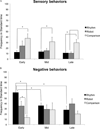A comparison of the effects of rhythm and robotic interventions on repetitive behaviors and affective states of children with Autism Spectrum Disorder (ASD)
- PMID: 26251668
- PMCID: PMC4523306
- DOI: 10.1016/j.rasd.2015.07.004
A comparison of the effects of rhythm and robotic interventions on repetitive behaviors and affective states of children with Autism Spectrum Disorder (ASD)
Abstract
Repetitive behaviors and poor affect regulation are commonly seen in children with Autism Spectrum Disorder (ASD). We compared the effects of two novel interventions - rhythm and robotic therapies, with those of a standard-of-care intervention, on the repetitive behaviors and affective states of 36 children with ASD between 5 and 12 years using a randomized controlled trial design. We coded for frequencies of sensory, negative, and stereotyped behaviors and the duration of positive, negative, and interested affective states in children during early, mid, and late training sessions. In terms of repetitive behaviors, in the early session, the rhythm and robot groups engaged in greater negative behaviors, whereas the comparison group engaged in greater sensory behaviors. With training, the rhythm group reduced negative behaviors whereas there were no training-related changes in the other groups. In terms of affective states, the rhythm and robot groups showed greater negative affect, whereas the comparison group demonstrated greater interested affect across all sessions. With training, the rhythm group showed a reduction in negative affect and an increase in interested affect whereas the robot group showed a reduction in positive affect. Overall, it appears that rhythm-based interventions are socially engaging treatment tools to target core impairments in autism.
Keywords: Music; affective states; autism; multisystem interventions; repetitive behaviors; rhythm; robots.
Figures



Similar articles
-
The effects of embodied rhythm and robotic interventions on the spontaneous and responsive social attention patterns of children with Autism Spectrum Disorder (ASD): A pilot randomized controlled trial.Res Autism Spectr Disord. 2016 Jul;27:54-72. doi: 10.1016/j.rasd.2016.01.004. Res Autism Spectr Disord. 2016. PMID: 27453721 Free PMC article.
-
The effects of embodied rhythm and robotic interventions on the spontaneous and responsive verbal communication skills of children with Autism Spectrum Disorder (ASD): A further outcome of a pilot randomized controlled trial.Res Autism Spectr Disord. 2016 Jul;27:73-87. doi: 10.1016/j.rasd.2016.04.001. Epub 2016 Apr 23. Res Autism Spectr Disord. 2016. PMID: 27668011 Free PMC article.
-
The Effects of Rhythm and Robotic Interventions on the Imitation/Praxis, Interpersonal Synchrony, and Motor Performance of Children with Autism Spectrum Disorder (ASD): A Pilot Randomized Controlled Trial.Autism Res Treat. 2015;2015:736516. doi: 10.1155/2015/736516. Epub 2015 Dec 17. Autism Res Treat. 2015. PMID: 26793394 Free PMC article.
-
Affective Communication for Socially Assistive Robots (SARs) for Children with Autism Spectrum Disorder: A Systematic Review.Sensors (Basel). 2021 Jul 30;21(15):5166. doi: 10.3390/s21155166. Sensors (Basel). 2021. PMID: 34372402 Free PMC article. Review.
-
Autism and social robotics: A systematic review.Autism Res. 2016 Feb;9(2):165-83. doi: 10.1002/aur.1527. Epub 2015 Oct 20. Autism Res. 2016. PMID: 26483270 Review.
Cited by
-
The benefit of rhythm-based interventions for individuals with autism spectrum disorder: a systematic review and meta-analysis with random controlled trials.Front Psychiatry. 2024 Sep 27;15:1436170. doi: 10.3389/fpsyt.2024.1436170. eCollection 2024. Front Psychiatry. 2024. PMID: 39398954 Free PMC article.
-
Digital interventions for autism spectrum disorders: A systematic review and meta-analysis.Pediatr Investig. 2024 Feb 25;8(3):224-236. doi: 10.1002/ped4.12417. eCollection 2024 Sep. Pediatr Investig. 2024. PMID: 39347529 Free PMC article.
-
A Pilot Study Comparing the Efficacy, Fidelity, Acceptability, and Feasibility of Telehealth and Face-to-Face Creative Movement Interventions in Children with Autism Spectrum Disorder.Telemed Rep. 2024 Mar 21;5(1):67-77. doi: 10.1089/tmr.2023.0061. eCollection 2024. Telemed Rep. 2024. PMID: 38558955 Free PMC article.
-
Multidimensional motor performance in children with autism mostly remains stable with age and predicts social communication delay, language delay, functional delay, and repetitive behavior severity after accounting for intellectual disability or cognitive delay: A SPARK dataset analysis.Autism Res. 2023 Jan;16(1):208-229. doi: 10.1002/aur.2870. Epub 2022 Dec 19. Autism Res. 2023. PMID: 36533674 Free PMC article.
-
Effectiveness of a Robot-Assisted Psychological Intervention for Children with Autism Spectrum Disorder.J Autism Dev Disord. 2024 Feb;54(2):577-593. doi: 10.1007/s10803-022-05796-5. Epub 2022 Nov 4. J Autism Dev Disord. 2024. PMID: 36331688 Free PMC article. Clinical Trial.
References
-
- American Psychiatric Association. Diagnostic and statistical manual of mental disorders. 5th edition ed. Arlington, VA: American Psychiatric Association; 2013.
-
- Bauminger N. The facilitation of social-emotional understanding and social interaction in high-functioning children with autism: Intervention outcomes. Journal of Autism and Developmental Disorders. 2002;32(4):283–298. - PubMed
-
- Bhat A, Landa R, Galloway JC. Current perspectives on motor functioning in infants, children, and adults with autism spectrum disorders. Physical Therapy. 2011;91(7):1116–1129. - PubMed
-
- Bishop SL, Richler J, Lord C. Association between restricted and repetitive behaviors and nonverbal IQ in children with autism spectrum disorders. Child Neuropsychology. 2006;12(4–5):247–267. - PubMed
Grants and funding
LinkOut - more resources
Full Text Sources
Other Literature Sources

